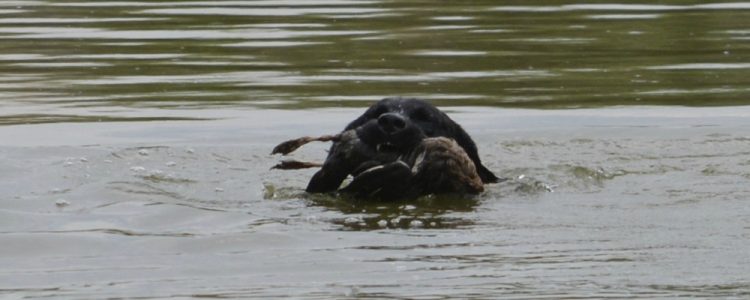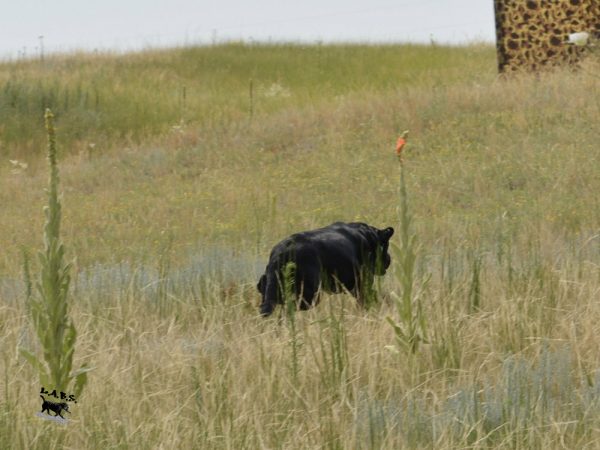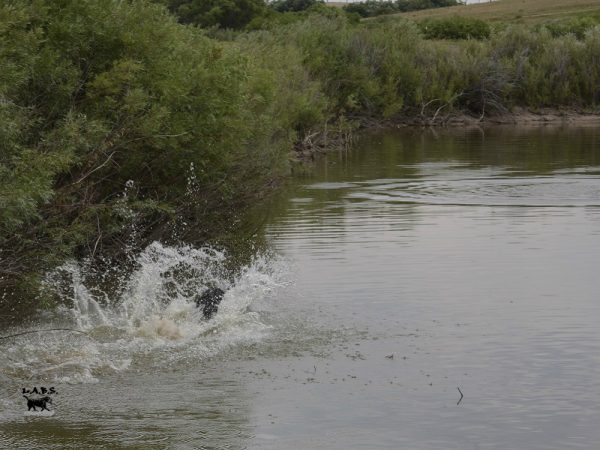
The Working Certificate - or just WC - is a fun test for Labs and their owners. One short retrieve on land and two back-to-back retrieves in water is all that's needed.
Some Labs take to it (dare I say?) like a duck to water. Other Labs take a bit of coaxing. That's where being a member of a local Lab club comes in handy.
There's also a Working Certificate Excellent, or WCX test, offered by some clubs. However the LRC only offers the WC test.
A bit of history
When The Labrador Retriever Club, Inc. was founded in 1931, The Kennel Club in England required sporting dogs prove working ability. Without it they could not earn a conformation title.
Using that as a guideline, the LRC created the WC test. It isn't a requirement under American Kennel Club rules. However the LRC requires members' dogs to have a WC before they can be called a show champion.
Requirements of the Working Certificate test
The WC requires your dog to retrieve a single shot bird at 50 yards. Generally pheasants or ducks are used with ducks being the most common. Sometimes pigeons are used.
Usually the birds are already dead and the gunshot is just a simulation. Live birds can be used, however that requires a good gunner and scrupulous safety measures.
This isn't a marking test like hunt tests and field trials. The core requirement is for your dog to retrieve a bird to you (or at least close to you). The judge will define how close your dog must bring the bird - generally within about five feet of you.
The retrieve doesn't have to be to hand or fast or even pretty.
Your dog doesn't have to be steady. You can restrain him by holding his collar or with a leash wrapped through the collar or wrapping your arms around him. For safety, the collar should not have dangling tags. They can be removed or taped securely to the collar.
Handling or directing your dog to the bird with hand signals or other commands is not permitted.
Your dog must also complete two back-to-back water retrieves to show a willingness to re-enter the water.
Download a copy of the WC brochure.
Differences between a WC and a Junior test
This is totally different from an AKC Junior test. It's not a marking test. It's only about retrieving. The questions is: Will your dog pick up a duck and bring it back to you?
If he drops the bird ten times, but makes progress back to you and gets the bird into your area, it's good.
It's a test of natural ability, not a test of how you trained your dog.
One dog's experience at the WC
The Labrador Retriever Club of Greater Denver hosted a Working Certificate test near Franktown, Colorado. The property was nicely set up for retriever training. Lots of people and dogs turned out for fresh air and some rather 'moist' skies!
Wynk started off with one mark on land - near the top of a little hill - no problem. But there was something new, something she'd never seen before. A blind (camo fabric) out in the field, hiding people.
'What's that?,' she asked. So she had to go take a peek and say hello to the bird boys. Then remembered she had to get her bird back to mom! Scooped it up as she ran back and delivered to hand. Land portion completed!

After a bit, we worked the water portion - back to back retrieves in a pond enclosed by tall reeds and other vegetation.
Another new experience for Wynk.
Out and back, delivered to hand for each mark, with her signature squeal as she left the line. Quite proud of my little Lab!

Photos by Linda Alexander.
Preparing for the Working Certificate test
Let's dive in to the what and how.
Lab clubs often have training days in preparation for an upcoming WC test. If you're not a member of one you can check for local Lab clubs.
If there isn't a Lab club nearby, try contacting other retriever clubs. Their training could be different than training for an LRC WC, but they may be able to accommodate your needs. Especially if you volunteer to help set up, throw birds, run a winger station, or tear down.
As a last resort, you can practice on your own. You will need at least one duck and a helper to throw the bird. To start, put your dog on leash and let him see and smell the bird. Waggle it around to get him interested, then toss it about five feet as you run out with him. Praise him for running to it. Praise for picking it up. Let him hold it for a bit. Then repeat, but no more than two or three times.
If it didn't go too well, try being more excited. Waggle the bird more. Pretend you're playing keep-away. Have your dog, on leash, watch another dog retrieve the bird. Praise for every tiny improvement.
To use the bird for multiple sessions, wrap it in newspaper and put it in a plastic bag. It will last longer if you freeze it in between sessions. You may also want to warn your family about the foreign object in the freezer.
Land retrieve
Your dog's manners getting from the holding blind to the line don't count. Just keep a firm grip on the leash.
It's a fairly short retrieve of about 50 yards.
The gunner often wears white to be very visible.
Get your dog to sit or stand next to you and facing the gunner. Take your time. When you're ready, restrain your dog in any way you want. Then signal or say you're ready.
After that the judge will signal for the gunner to start. Wait for the judge to release you by saying your number or something like "dog." This gives the judge time to call a "no bird" if something went wrong. You don't have to release your dog immediately.
The bird will be thrown into light cover and should be relatively easy for your dog to find. There could be a small hunt or, in some cases, a big hunt.
You can encourage your dog. Find it, fetch it up, where is it? are all good. You can use a whistle. You can do almost anything you want to get your dog to pick up the bird and bring it back. Ask the judge if you're not sure.
The main objective is for your dog to pick up the bird and bring it back to you. The judge may require him to cross a specific line or he might have an area marked out.
Your dog can sit at heel and present the bird. Or drop it near you. Or, if you're quick and agile enough, you can snag the bird as your dog rockets by you.
Any way you get it, hand the bird to the judge or a "bird boy" and you're done. For now.
Water retrieves
These test whether your dog will re-enter the water after retrieving the first bird. Again it's not a marking test. The core requirement is for him to go back in the water to retrieve a second bird.
Each bird is thrown and retrieved separately. It's not like a double marked test.
Your dog doesn't have to deliver to hand, but should bring the bird up onto dry land. He can be coaxed if needed to get him into the receiving area. He can also run the bank, but must bring the bird to you.
There's no rush to do the second retrieve. Get your dog under control and looking out where the next bird is going to be. Signal for the bird when you're ready.
Once your dog has delivered the second bird to the area of the handler, you're done. Take a breath!
After all the dogs have run, and your dog passed, you will get a form signed by the judge(s). Send that form to the LRC with the fee (currently $25) to get your working certificate. Some clubs give out their own certificate and/or a rosette to passing dogs to commemorate their success.
Other ways to earn a WC
If there isn't a Lab club near you that hosts WC tests, here are some alternatives:
- Complete both a land and water series in an AKC licensed field trial or receive a placement or judge's award of merit in an AKC licensed field trial
- Complete an AKC Junior hunter title
- Earn one leg in an AKC Senior or Master test
And there you have it!
The WC test is a great way to get a feel for running a dog in field events. Young people are encouraged to give it a try. Many experienced handlers had their first taste of field events at a WC test.
It's also a good way for reputable breeders to show the working ability of their dogs. And it gives Lab owners appreciation for their dog's abilities without a big commitment to field training.
I hope you will get involved in field work with your Lab. Happy training!
--
This article was originally published on July 24, 2018. Updated on May 10, 2024.


